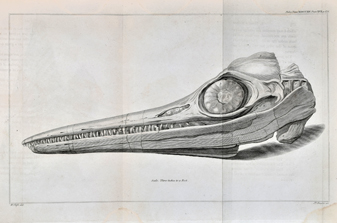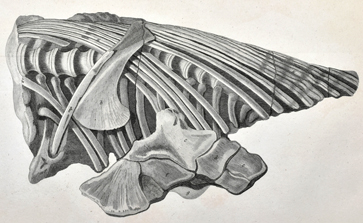
|
 |
Engravings of the incomplete ichthyosaur found by Joseph and Mary Anning between 1811-1812, by James Basire after drawings by William Clift (GSL membership no.484), from E Home, "Some account of the fossil remains of an animal more nearly allied to fishes than any of the other classes of animals”, Philosophical Transactions of the Royal Society, vol 104 (1814). GSL Library collections.
|
These images show the Anning family’s first major discovery, an ichthyosaur Temnodontosaurus platyodon. The four-foot-long skull was discovered by Joseph sometime in autumn 1811, with the section of vertebral column and ribs discovered by the 13-year-old Mary in November the next year.
Fragmentary specimens of ichthyosaurs, frequently referred to as ‘fossil crocodiles‘, had been found before. However, this discovery became famous as it initiated the first scientific description of these dolphin-like, marine reptiles.
The specimen was purchased by Henry Hoste Henley, a local landowner in Lyme, for £23 (equivalent to around £1000 in today’s money) and sent onto William Bullock (c.1773-1849, GSL membership no.644) for his Egyptian Hall museum in Piccadilly, London. It was here that it came to the attention of the Hunterian curator Everard Home (1756-1832, GSL membership no.485) who used it as the subject of his paper “Some account of the fossil remains of an animal more nearly allied to fishes than any of the other classes of animals” which was read before the Royal Society in June 1814.
As was not uncommon during the period, the Annings as finders of the specimen are not mentioned. Instead as provenance Home cites only the previous owner:
"This specimen was found upon an estate of Henry Host Henley, Esq. between Lyme and Charmouth, in Dorsetshire, in a cliff thirty or forty feet above the level of the sea-shore. It had been thrown down by the breaking off of a part of the cliff, and buried in the sand upon the shore, to the depth of nearly two feet. The skull was dug out in 1812 [sic], the other parts in the following year, at a distance of some feet.
The cliff is composed of that species of argillaceous limestone called blue lias, in which the fossil bones were deposited. Above the lias there is only a thin layer of black earth.” From E Home, “Some account of the fossil remains of an animal more nearly allied to fishes than any of the other classes of animals”, Philosophical Transactions of the Royal Society, vol 104 (1814).
Home’s first paper on ichthyosaurs was essentially an anatomical description of the fossilised remains, in which he attempted to compare it with modern species in order to try and identify what it was. Although the vertebrae shared similarities with modern fish, he suggested that the jaws and scapula bore some resemblance to crocodiles, whilst other bones seemed closer to that of turtles.
Home returned to the subject in two other papers in 1816 and 1818, using fragments from fossilised remains supplied by others including the collector James Johnson (1764-1844) and William Buckland (1784-1856, GSL membership no.241), recently appointed Professor of Mineralogy at Oxford University, in an attempt to fill in the missing parts of the skeleton. In particular the shape of the sternum, which had been noticed by Buckland, led Home to find similarities with Ornithorhynchus paradoxus or duck-billed platypus.
Ichthyosaurs first appeared during the Triassic Period (c.240 million years ago) and became extinct in the late Cretaceous Period (c.90 million years ago). The Annings' specimen dates from the Lower Jurassic Period (c.200 million years ago). It was sold at auction in 1819 for £47 5s and can now be found at the Natural History Museum.
<<Back